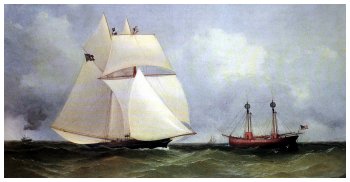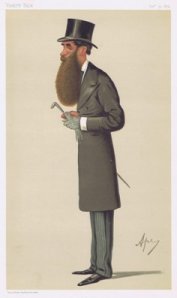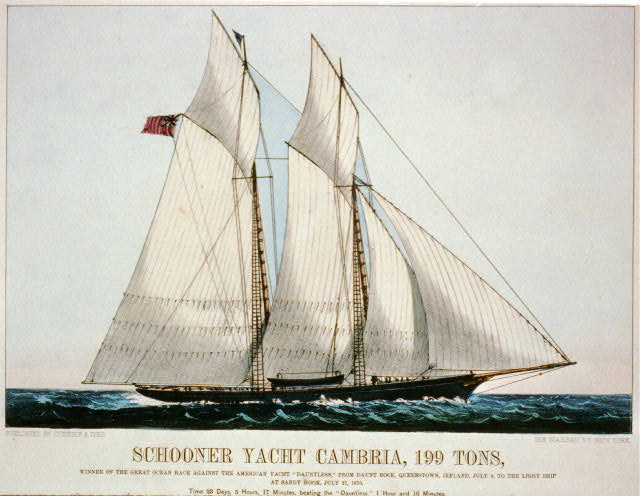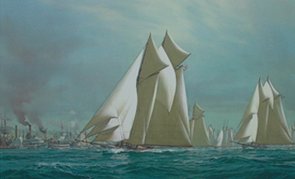Yves GARY Affichages : 4086
Catégorie : CAMBRIA
 Premier challenger de l'America's Cup
Premier challenger de l'America's CupCambria a affronté seul une flotte de 14 defenders new-yorkais. Magic remporta cette course, Cambria se classa huitième en temps réel à 27 minutes et 3 secondes du premier (dixième en temps compensé, à 39 minutes et 8 secondes de Magic).
La goélette a été dessinée et construite par Michael Ratsey, à Cowes, sur l'île de Wight, pour James Lloyd Ashbury.
 Fils d'un charron de Manchester qui a inventé un chariot sur rail, James Lloyd Ashbury ne se contente pas d'avoir la fortune. Il est avide de reconnaissance sociale et multiplie les coups d'éclat pour s'attirer les faveurs de tous, en particulier celles de la haute société, ce qui explique son engagement dans de nombreux yacht-clubs de Grande-Bretagne, comme le Royal Harwich et le Royal Thames Yacht Club.
Fils d'un charron de Manchester qui a inventé un chariot sur rail, James Lloyd Ashbury ne se contente pas d'avoir la fortune. Il est avide de reconnaissance sociale et multiplie les coups d'éclat pour s'attirer les faveurs de tous, en particulier celles de la haute société, ce qui explique son engagement dans de nombreux yacht-clubs de Grande-Bretagne, comme le Royal Harwich et le Royal Thames Yacht Club.
En 1868, Ashbury commissionne Michael Ratsey et se fait construire une goélette de 188 tonneaux baptisée Cambria - d'après le nom de la Cambrian Railway, une compagnie dans laquelle James a d'importantes participations. La même année, la goélette américaine Sappho à Richard Poillon, arrive à Cowes. Une course est organisée autour de l'île de Wight où se retrouvent les cotres Condor et Oimara et les goélettes Sappho, Aline et Cambria. Cette dernière remporte l'épreuve, Sappho finit bonne dernière, à 1 heure 30 du premier ! Pour Ashbury, ce succès est déterminant : il décide de lancer un défi au NYYC pour conquérir la Cup gagnée par America en 1851.
Son obsession de se faire remarquer l'empêche de disputer le match en 1869, car il a tenu à ce que Cambria soit le premier yacht britannique à passer le canal de Suez, le 17 novembre 1869. Au printemps 1870, Sappho, profondément refondue, est à nouveau dans les eaux anglaises. Les 10, 14 et 17 mai, elle dispute trois matches contre Cambria qui est sévèrement battue. Cela n'inquiète pas James Ashbury qui négocie avec le propriétaire du New York Herald Tribune, James Gordon Bennett également présent avec sa goélette Dauntless, une course transatlantique vers New York avant de courir la première America's Cup de l'histoire. Après 23 jours, 5 heures et 17 minutes, Cambria, à bord de laquelle se trouve Ashbury, arrive en tête et bat Dauntless d'une heure et 43 minutes.
 Cambria va devenir le premier challenger d'une longue série à être battu dans l'America's Cup. Ce sera l'unique fois où l'épreuve sera disputée en flotte malgré le souhait d'Ashbury de ne se voir opposer qu'un seul defender. Il aura gain de cause l'année suivante, car dès ce mois d'août 1870, le bouillonnant Anglais passe commande à Michael Ratsey d'une nouvelle goélette pour son prochain défi !
Cambria va devenir le premier challenger d'une longue série à être battu dans l'America's Cup. Ce sera l'unique fois où l'épreuve sera disputée en flotte malgré le souhait d'Ashbury de ne se voir opposer qu'un seul defender. Il aura gain de cause l'année suivante, car dès ce mois d'août 1870, le bouillonnant Anglais passe commande à Michael Ratsey d'une nouvelle goélette pour son prochain défi !
En attendant, James prend sportivement sa défaite. Yachtsman passionné, il participe activement à la croisière annuelle du NYYC, entre New York et Newport et retour. Cambria dispute de nombreuses régates. Elle figure souvent à la seconde place et ne s'adjuge qu'une seule victoire dans un match contre Idler.
Doté d'un sens aigu de la relation publique, James Ashbury reçoit à son bord pour déjeuner le président des Etats-Unis, le général Grant en personne !
Sur la côte Est, la saison des régates touche à sa fin. Après un dernier match disputé et perdu contre Dauntless, Cambria retourne en Angleterre. La goélette n'est plus inscrite à la plaisance et est rapidement vendue.
Ses nouveaux propriétaires vont l'employer au commerce, avec quelques profits, pour faire du cabotage le long des côtes de l'Ouest africain. Cambria disparaîtra en mer, un jour de grande et soudaine tempête.
 ... As the Cambria claimed to be the champion schooner in British waters last year, I kept an eye on her doings at both sides of the Atlantic, and think they fully justify that denial of her right to be so considered which I ventured to make in last year’s notes. In England she sailed in May two matches with Sappho and was beaten hollow, refusing to start in the third.
... As the Cambria claimed to be the champion schooner in British waters last year, I kept an eye on her doings at both sides of the Atlantic, and think they fully justify that denial of her right to be so considered which I ventured to make in last year’s notes. In England she sailed in May two matches with Sappho and was beaten hollow, refusing to start in the third.
• June 4th.—In the match of the New Thames Club to Harwich, was beaten without time allowance by Fiona and Egeria.
• June 8th—In the schooner match of the Royal Thames Yacht Club, was beaten without time by Gloriana, Egeria, and Flying Cloud.
• June 9th.—In the schooner match of the Royal London, was beaten by Egeria without time.
• June 10th.—In the schooner match of the New Thames, was beaten without time by Egeria, and on time by Flying Cloud.
• June 11th.—In the Royal Thames schooner match from the Nore to Dover, was beaten in very strong weather on time by Egeria.
• June 13th.—She won the Town cup from Dover to Boulogne and back.
• June 14th.—In the Royal London match for Mr. Broad wood's prizes from Dover to Cowes, was beaten without time by Fiona, Julia, Guinevere, Egeria, and Vindex.
She then started on 4th July, in her race to America, in which by better navigation or a luckier course she beat the Dauntless by one-and-a-half hours. In America, August 8th.—Was beaten for the cup won at Cowes, in 1851 by the America, by the Magic schooner and six others, including the old America herself.
• August 16th.—For a cup given by Mr. Ashbury himself, she was again beaten by the Magic, but won the second prize for schooners.
• September 8th.—She was a third time beaten by the Palmer for a cup given by Vice-Commodore Bennett, but again got second prize.
• September 10th.—For Newport cup in strong weather the Phantom, Palmer, and Dauntless beat her handsomely.
• September 28th.—For cups given by Mr. Douglas, Mr. Sturveysant, Mr. Ashbury, and the New York Yacht Club, she could do nothing with Dauntless, Tidal Wave, Madeline, Palmer, Idler, Alarm, and Madjie, who all beat her.
 In match making she was little more successful.
In match making she was little more successful.
• August 17th —In a contest 20 miles dead to windward and back she was beaten by the Palmer by 17m. 9s.
• August 18th —She beat the Idler in a similar match 8m. 43s.
• September 9th.—She was beaten by Phantom, 22m. 10s., and on same day by Madeline on time.
• October 18th.—She was trounced by Sappho to the moderate tune of 50m. 50s.
• October 19th.— She wound up her American score by losing to Dauntless by 11m. 30s.
Thus in England this year she sailed seven races and won one; two matches and lost both—in America she sailed five races and won two second prizes, six matches and won one, hardly good enough form to go so far to show off, while to judge from the accounts in your Magazine the handling was at times not much more remarkable than the result. The new vessel is described as likely to be fast, and is big enough to meet the American vessels likely to come over here on fairer terms, but is in point of size quite an over match for the vessels here except the Guinevere, and ought especially in channel races to have it all her own way...
